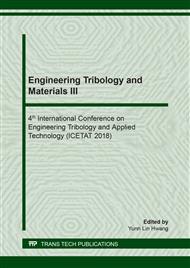p.1
p.9
p.15
p.21
p.27
p.33
p.41
p.53
Effect of Silica Nanoparticles on Wear Mechanism of Alginate-Polyacrylamide Hydrogel Matrix as a Load-Bearing Biomaterial
Abstract:
Hydrogels’ promising biocompatibility and biomimetic lubrication mechanism have led to widespread biomedical applications. To be eligible for load-bearing applications, such as cartilage reconstruction, they must be highly wear-resistant and induce ultra-low friction, once being implanted in vivo. In this study, Scanning Electron Microscopy was utilized on the worn surface of silica-nanoparticle reinforced Alginate-Polyacrylamide nanocomposite hydrogels (NCHs), as well as unmodified hydrogel as control samples, as a means of wear mechanism investigation, which is quite under-explored for these materials. Our results showed adhesion was the most prevalent wear mechanism in both NCHs and unmodified hydrogel matrix, while fatigue wear was observed in the form of surface pitting under highest load and highest test period conditions. Nevertheless, Si-NP was found to improve the wear-resistance of hydrogel matrix, as less severe surface deformation and pitting was inspected on the surface of NCHs.
Info:
Periodical:
Pages:
15-20
Citation:
Online since:
September 2019
Authors:
Price:
Сopyright:
© 2019 Trans Tech Publications Ltd. All Rights Reserved
Share:
Citation:


